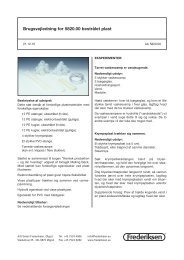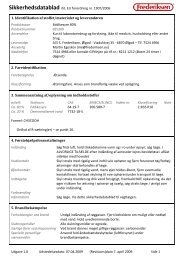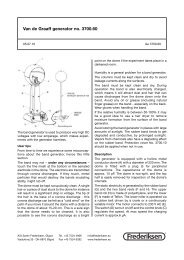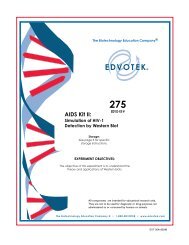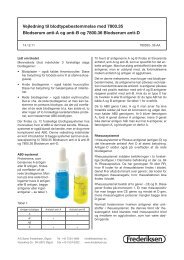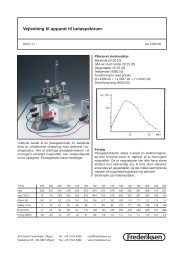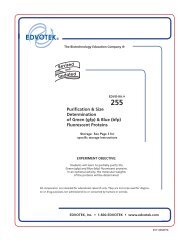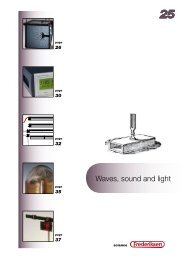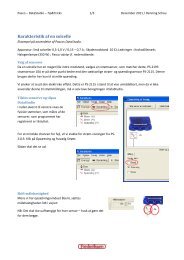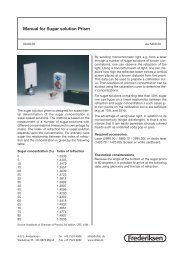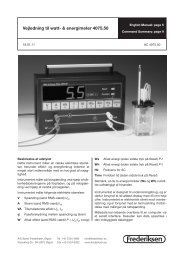type wxg-4 disk polarimeter operating instructions - Frederiksen
type wxg-4 disk polarimeter operating instructions - Frederiksen
type wxg-4 disk polarimeter operating instructions - Frederiksen
Create successful ePaper yourself
Turn your PDF publications into a flip-book with our unique Google optimized e-Paper software.
TYPE WXG-4<br />
DISK POLARIMETER<br />
OPERATING INSTRUCTIONS<br />
1
Contents<br />
I、 Applications and Applicable Ranges<br />
II、<br />
III、<br />
IV、<br />
Main Specifications<br />
Principle of Operation<br />
Construction of the Instrument<br />
V、 Method of Operation<br />
VI、<br />
VII、<br />
Maintenance of the Instrument<br />
Complete Set of the Instrument<br />
2
I、Applications and Applicable Ranges<br />
Type WXG—4 <strong>disk</strong> <strong>polarimeter</strong> can be used in the chemical industry, hospitals,<br />
colleges and universities and scientific research in situations, for measuring the<br />
organic substances with optical rotation. With the aid of the <strong>disk</strong> <strong>polarimeter</strong>, the<br />
specific gravity, purity, concentration, and content of thousands of active materials,<br />
such as sugar solution, turpentine oil and camphor, can be measured. For example: In<br />
the food industry: The <strong>disk</strong> <strong>polarimeter</strong> can be used to inspect the sugar content and to<br />
measure the asylum content of the food flavorings. In the clinic and hospital: The <strong>disk</strong><br />
<strong>polarimeter</strong> can be used to measure the sugar content and protein in urine. In the sugar<br />
refinery: The <strong>disk</strong> <strong>polarimeter</strong> can be used to inspect the concentration of the sugar<br />
solution in industrial process. In the medicines and perfumery industry: The <strong>disk</strong><br />
<strong>polarimeter</strong> can be used to measure the optical rotation of the medicines and<br />
perfumery oil. In colleges and universities: The <strong>disk</strong> Polarimeter can be used in<br />
teaching experiments.<br />
II、Main Specifications<br />
1. Measuring Range of Optical Rotation ±180<br />
2. Division Value 1°<br />
3. Dial Venire Value in Reading 0.05°<br />
4. Magnifying Factor of the<br />
Magnifying Glass<br />
4times<br />
5. Monochromatic Light Source 5893A°<br />
(Sodium Lamp)<br />
6. Length of Test Tube 1 each<br />
(100mm and 200mm)<br />
3
7. Power Source of the Instrument<br />
Power Line Voltage<br />
220V / 50Hz<br />
Working Current 1.3A<br />
Discharging Power<br />
Stabilization Time<br />
20W<br />
a bout 5minutes<br />
8. Weight of the Instrument 5 kg<br />
9. Overall Dimensions 540×220×380(mm)<br />
III、Principle of Operation<br />
The principle of operation of the <strong>polarimeter</strong> is established on the basis of the<br />
polarized light. In addition, by use of the method of rotating the polarized plane of the<br />
polarization light, its measuring purpose can be attained. At the position of zero<br />
degree, AA´ is Perpendicular to the centerline OX.<br />
AA’ (shown in the above Figure) indicates the vibration direction of the polarization<br />
analyzer, and OP and OP’ indicate the vibration directions of the polarized lights of<br />
the two halves of the viewing field. When the light beam passes through the optical<br />
rotators substance, the plane of polarization is rotated by an angle of α, as shown by<br />
4
the dotted line in the above Figure. Now, the projections of the polarized lights of the<br />
two halves on AA’ are not identical, the right half is bright, and the left half is dark. If<br />
rotating the polarization plane AA’ of the analyzer by an angle of α in the same<br />
direction, the illumination intensity of the viewing field can be made equal again: At<br />
this time, the rotated angle of the polarization analyzer is the optical oration of the<br />
substance. Knowing the rotated angle (i.e. the optical rotation), the length of solution<br />
column (i.e. the length of the test tube) and the concentration, the specific optical<br />
rotation (i.e. the optical rotatory power or the specific rotation) of the substance can<br />
be calculated in accordance with the following formula:<br />
t<br />
[ α ] × 100<br />
λ<br />
= lC<br />
Q<br />
Where, Q— the rotation angle (optical rotation) measured by use of light λ,<br />
when the temperature is t.<br />
L— the length of solution column (test tube), using decimeter<br />
(dm) as the unit of the length.<br />
C— concentration, i.e. the gram quantity of the solute in 100mm<br />
of solution.<br />
Form the above formula, we can see that the rotation angle Q is in direct<br />
Proportion to the solution column (the tube) length L and the<br />
concentration C,<br />
i.e.<br />
Q=[α]LC<br />
Also, the optical rotation has relations with the temperature. As for most<br />
substances, λ=589.3nm (sodium light)can be used in the measurement,<br />
when the temperature rises by 1ºC, the optical rotation will reduce by 0.3%.<br />
Thus, for the measurement with higher requirements, it had better to make<br />
the measurement under a working circumstance of 20±2ºC.<br />
5
IV. Construction of the Instrument<br />
1. Principle of the Instrument(See Fig.1)<br />
Fig .1 System diagram of the instrument.<br />
1. Light Source(Sodium Light)<br />
2. Collector lens<br />
3. Color Filter<br />
4. Polarizer<br />
5. Half-wave Plate<br />
6. Test Tube<br />
7. Polarization Analyzer<br />
8. Object Lens<br />
9. Eye Lens<br />
10. Magnifying Glass<br />
11. Dial Venire<br />
12. Dial Rotary Hand-wheel<br />
13. Protective Plate<br />
After the light coming from the light source (1) has been projected on the collector<br />
lens (2). Color filter (3), and Polarizer (4),it becomes a plane linear polarized light,<br />
and after the polarized light passes through the half-wave plate(5) and is decomposed<br />
into normal light and abnormal light, a triplex view-aspect will occur in the viewing<br />
field. The test tube (6) containing the optical rotatory substance is put into the sample<br />
chamber for measurement. Since the solution has optical activity, the plane-polarized<br />
6
light is rotated by an angle, so that the polarization analyzer (7) can play a role of<br />
analysis. Observing through the eye lens (9), we can see a mid-bright (or dark) and<br />
left/right-dark (or bright) triplex viewing field of unequal intensity of illumination<br />
(see Fig.2a and fig.2b).<br />
Rotate the dial rotary hand-wheel (12) so as to drive the dial (11) and the polarization<br />
analyzer (7), until the illumination intensity of the viewing field (dark viewing field)<br />
becomes equal (see Fig.2c). Then, the angle of dial rotation can be read out from the<br />
magnifying glass (see Fig.3).<br />
After rotating the polarization analyzer, the illumination intensity becomes equal, i.e.<br />
the zero-position viewing field before putting in the solution.<br />
2. Construction of the Instrument<br />
For easy operation, the optical system of the instrument should be mounted on the base<br />
frame in an inclination of 20º. The light source uses 20Wsodium lamp (the wave length<br />
λ=589.3nm).The current limited of the sodium lamp is mounted at the bottom of the<br />
base frame so external current limited is not needed. The polarizers of the instrument<br />
are all polyvinyl-alcohol artificial polarizing discs. The triplex viewing-aspect uses<br />
Laurent quartz slab device (half-wave plate).By rotating the polarizer, the shadow angle<br />
of the triplex viewing field can be adjusted. (When leaving the factory, the<br />
above-mentioned shadow angle is regulated to about 3.5°). In order to eliminate the<br />
eccentric difference, the Instrument uses double-vernier in reading, the dial is divided is<br />
7
divided into 360 divisions and each division indicates 1°. The vernier is divided into 20<br />
divisions which are equal to 19 divisions of the dial, and the vernier can be used to<br />
obtain a direct reading to the extent of 0.05° (see Fig.3). The dial and the polarization<br />
analyzer are fixed integrally. The hang-wheel (12) can be used to make coarse and fine<br />
rotation. Two pieces of magnifying glasses (the magnifying factor is 4 times) are<br />
mounted in front of the vernier window, which can use in reading.<br />
Q=9.30°<br />
Fig.3<br />
V. Method of Operation<br />
1. Preparations:<br />
(1) Compound the solutions to be measured, then have the solution stabilized.<br />
(2) Pour the solution to be measured into the test tube for measurement. Caution: the<br />
screws at the both ends of the test tube should not be screwed in too tightly (usually<br />
screw down the screws with hand conveniently until no water leak occurs), so as to<br />
prevent the protective plate from producing strain which may cause the illumination<br />
change of the viewing field and affect the accuracy in measurement. Then, wipe the<br />
remained liquid at the both ends clean. (3) Connect the power source, and turn on the<br />
sodium lamp for about 10 minutes. Only when the lamp gives out yellow sodium light,<br />
the observation can be made.<br />
(4) Check for the zero-position of the dial. If the zero-position is not correct, you may<br />
8
unscrew the four connecting screws in the dial’s cover, so to rotate the dial’s shell for<br />
correcting the zero-position (only 0.5° below can be corrected) or you may add or<br />
subtract the error value.<br />
2. Measurement<br />
(1) Open the cover of the lens cone, and put the test Tube into the lens cone for<br />
measurement. Then, close the cover of the lens cone and have the bulb part of the<br />
test tube to be upward, so that the air bubbles can be stored in the bulb part and<br />
the observation and measurement will not be affected. Adjust the viewing field<br />
screw, until the triplex viewing aspect in the viewing field becomes distinct.<br />
Rotate the dial hang-wheel until the illumination of the viewing field (the dark<br />
viewing field) becomes identical.<br />
(2) Read out the angle rotated by the dial through the magnifying glass.<br />
(3) According to the formulas described above, calculate the specific gravity,<br />
concentration, purity and content of the substance.<br />
VI. Maintenance of the Instrument<br />
1. The instrument should be positioned at a place with circulation of air. Appropriate<br />
temperature, and lower humidity, so as to prevent the optical parts and polarizing<br />
discs from being moistened and mildewed, and avoid affecting the performance of<br />
the instrument.<br />
2. The time for continuously using the sodium lamp tube should not exceed 4 hours.<br />
When the sodium lamp tube is being used for a long period of time, the electric<br />
fan must be used, or the sodium lamp should be turned off for 10-15 minutes so as<br />
to get it cooled before using it again If the lamp tube could only give out red light<br />
and could not give out yellow light, it usually means that this is caused by too low<br />
an input voltage (less than 220V). In such a case, you should think of a way to<br />
increase the voltage up to about 220V.<br />
9
3. After being used, the test tube should be rinsed and cleaned with water or distilled<br />
water, and should be wiped clean and stored up.<br />
4. Never use unclean and hard cloth or paper to wipe the optics, so as to prevent the<br />
surfaces of the optics from being scared.<br />
5. When lying idle, the instrument should be stored in a box, or covered with a<br />
plastic cover, so as to avoid the invasion of the dust.<br />
6. When being Packed, the instrument, sodium lamp tube the test tube, and so on<br />
should be placed at the assigned positions, so as to avoid being crushed.<br />
7. Never disassemble and assemble the instrument at will, especially for those who<br />
know little about the measuring accuracy of the instrument will be affected. If<br />
there is some trouble or something wrong with the instrument, the instrument for<br />
repair, so that the lifetime and measuring accuracy of the instrument can be<br />
guaranteed.<br />
VII. Complete Set of the Instrument<br />
1. Disk Polarimeter 1 set<br />
2. Sodium Lamp Tube 2 Pieces (1Spare)<br />
3. Test Tube (100mm 200mm) 1 Piece/each<br />
4. Test Tube Protective Plat 4 Pieces (spare)<br />
5. Test Tube Rubber Washer 8 Pieces (spare)<br />
6. Small Screw Driver 2 Pieces<br />
7. Drier 1 bag<br />
8. Plastic Cover for the Instrument 1 Piece<br />
9. Fuse (3A) 3 Pieces<br />
10



